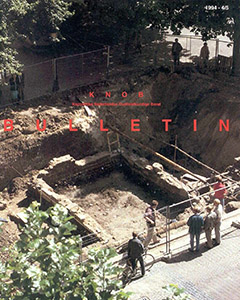Indexering ESCI / Scopus


De oudste kerken van Utrecht, een inleiding van de redactie hij het themanummer over het Domplein. H.L. de Groot: De Heilige Kruiskapel te Utrecht. Die Tatsachen bleiben, die Interpretation schwänkt. Raphaël Rijntjes: De ecclesiola in het Utrechtse castellum. Bouwhistorische interpretatie van de resten van de Heilig-Kruiskapel. Charlotte J.C. Broer en Martin W.J. de Bruijn: De Heilig-Kruiskapel in Utrecht: Sint-Maarten of Sint-Salvator? R.J. Stöver: De afmetingen van de Salvator- of Oudmunsterkerk in de afbeeldingen van de Monumenta van Van Buchel en in de collectie Booth: Toetsing en interpretatie aan de hand van opgravingsresultaten. Eelco van Welie: Omnes canonici. Een verkenning van de Utrechtse stadsliturgie.
As is generally assumed, there was a small church within the walls of the Roman castellum as early as the seventh century. It is likely that it was founded by the Merovingian king Theutbert II (586-612) or his successor Chlotarius II (584-629) and destroyed by the Frisians. Around 695 Willibrord rebuilt the destroyed church and consecrated it to St Maarten (St Martin), possibly as a sign of gratitude towards the Frankish king, whose mayor of the palace, Pippijn II, supported him in his missionary work. Next to it he built a second church, St Salvator. He connected this church with a...
The 're-excavation' in 1993 of part of the foundations and above-ground walling of the Heilig-Kruiskapel has revealed new data with respect to the history of its construction. The most important conclusion is that the southern annex of this chapel was a separate unit and as such it was the seventh-century predecessor of the church attached to it later. It is likely that the Heilig- Kruiskapel itself is to be identified with the St Maarten's church built by Willibrord.
This hypothesis on the basis of architectural-historical findings implies that a new architectural structure is...
For centuries there has been a small chapel at Dom square in Utrecht, squeezed in between Dom cathedral, consecrated to St Maarten, and the church of St Salvator or Oudmunster: the Heilig- Kruiskapel. In the thirties this chapel was dated to the tenth century by the archaeologist A.E. van Giffen.
However, a few years ago the Utrecht town archaeologist H.L. de Groot expressed the assumption that we are dealing with a church from the end of the seventh century here, notably with the first St Maarten's church rebuilt by the Anglo-Saxon missionary Willibrord on the foundations of an...
In 1587 the curtain fell for one of the very oldest churches of Utrecht. For in that year the town council decided to pull down Salvator or Oudmunster church. The demolition started soon after the decision had been taken. This church, founded by Willibrord in the former castellum Traiectum around 700, was situated at just a very short distance to the south of St Maarten's Dom Cathedral.
In spite of the total demolition of the building, even most foundations were excavated, the church did not sink into oblivion. The church has been passed down to us through a small series of...
The unity of the urban Christian community, dating back to early Christianity, as an idea lying at the root of the stational organization of the cathedral city, gave way to an urban liturgy of a distinctly clerical, in Utrecht even 'collegial' character during the high and late Middle Ages. For Utrecht liturgy distinguishes itself from urban liturgy as it proceeded in other medieval cathedral cities by a focus on five main churches.
The desire to celebrate the commemoration of the saint in his own sanctuary, combined with the need to visualize and confirm the mutual relations...


open access mogelijk gemaakt door Stichting OpenAccess
